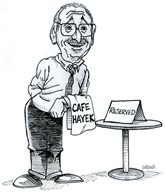On page 33 of their October 2021 paper, “On the Persistence of the China Shock,” David Autor, David Dorn, and Gordon Hanson write the following:
It does not appear, however, that regional variation in labor market regulations account for differential adjustment to the China shock. The impacts of trade exposure were no less acute in CZs [commuting zones] located in right-to-work states or states with lower minimum wages (Chan, 2019).
The paper cited is Jeff Chan’s “Labour Market Characteristics and Surviving Import Shocks,” which was published in the May 2019 issue of The World Economy. I have no ready on-line access to this journal, but I do have – and have read – this 2018 SSRN version of Chan’s paper.
The abstract of Chan’s paper reads:
This paper investigates whether different labour market characteristics amplify or dampen the local labour market impacts from Chinese import competition exposure. I exploit state-level variation in initial, pre-shock labour market characteristics and regional variation across local labour markets in exposure to Chinese imports for identification. I find that local labour markets in states with higher union density experience more severe adverse consequences as a result of increased import exposure. Conversely, higher initial minimum wages help mute the negative impacts of the China shock. I also provide some evidence that exceptions to employment-at-will legislation can affect employment responses to increased Chinese imports. Finally, examining all policies together in an index, I show that higher levels of policies intended to benefit and protect workers can actually magnify the extent of the damage inflicted by import competition. My results suggest that initial labour market characteristics and policies can play an important role in understanding why local labour markets react differently to trade shocks.
Two mysteries.
Mystery one is that nowhere in Chan’s paper is there any mention of right-to-work states and non-right-to-work states. Chan does study the effects of unionization on the responses of different locales (“commuting zones”) to increased imports from China, but unionization is not synonymous with non-right-to-work. I read the SSRN version of Chan’s paper pretty carefully and don’t believe that I would have missed Chan having tested for the effects of right-to-work legislation on the employment responses across locales to increased import competition from China. Moreover, as mentioned below, Chan finds that unionization worsened the labor-market effects of the China Shock. So unless the final, World Economy version of Chan’s paper contains an entirely new statistical test that isn’t in the SSRN version – which strikes me as very unlikely – I’m mystified how Autor, Dorn, and Hanson can conclude that Chan’s paper supports the proposition that “the impacts of trade exposure were no less acute in CZs located in right-to-work states.”
Mystery two is broader. Autor, Dorn, and Hanson seem to cite Chan’s paper in support of the proposition that, as they put it, “it does not appear, however, that regional variation in labor market regulations account for differential adjustment to the China shock.” As I read Chan’s paper, his conclusion is quite the opposite. Re-read the Chan abstract above. And see also page 29, where Chan writes, in his paper’s concluding section, that
I provide some evidence that higher levels of policies that protect workers [DBx: increasing employers’ costs of firing workers] can increase the damage inflicted by the China shock. These findings imply that, although there is heterogeneity in which policies influence which outcomes’ responses, labour market policies and char- acteristics intended to benefit workers can magnify the wage and employment losses stemming from the so-called China syndrome labelled by Autor et al. (2013).
And although the extent of labor unionization isn’t identical with labor-market regulation, these passages on pages 21 and 22 of Chan’s paper are nevertheless notable:
Commuting zones in states with an above-median level of union density (column 3), in response to in- creases to Chinese import exposure, suffer decreases to manufacturing employment population share, the non-manufacturing employment population share, logged average wages that are twice as large in magnitude to commuting zones in states with below-median union density (column 2) that experience an import shock of the same size. Similarly, these high-unionization CZs also suffer increases to the unemployment population share, the share of the population not in the labour force, and total government transfers per capita that are more than twice the magnitude of the increases in low union density CZs.
…..
The resulting estimates show that high union density CZs experience a statistically stronger, larger in absolute magnitude, response to the China shock in terms of manufacturing employment share, the unemployed share, and in terms of government transfers per capita, with estimated coefficients that are 2.1, 3.5, and 5.1 times the magnitude, respectively. While the other outcome variables did not return estimates that were statistically different, it should nonetheless be noted that, for all outcome variables except non-manufacturing employment shares which are not significant in the original Autor et al. (2013) results either, the estimated coefficients for the China shock are larger in magnitude in high union density CZs, and are statistically significant within each subsample.
Chan’s paper, in short, mostly says the opposite of what Autor, Dorn, and Hanson cite it as saying.
One possible solution to this mystery is that Autor, Dorn, and Hanson mistakenly inserted, in the passage from them quoted above, a citation to the Chan paper when they intended to cite another paper or papers. (I have more than once made such a mistake.) But in their paper they cite the Chan paper only twice: the one mentioned above, and in a footnote (#4) that lists various papers on (in their words) “how trade-shock impacts are mediated by labor market conditions.”
As I say, a mystery.



